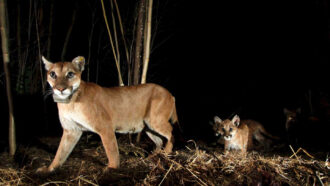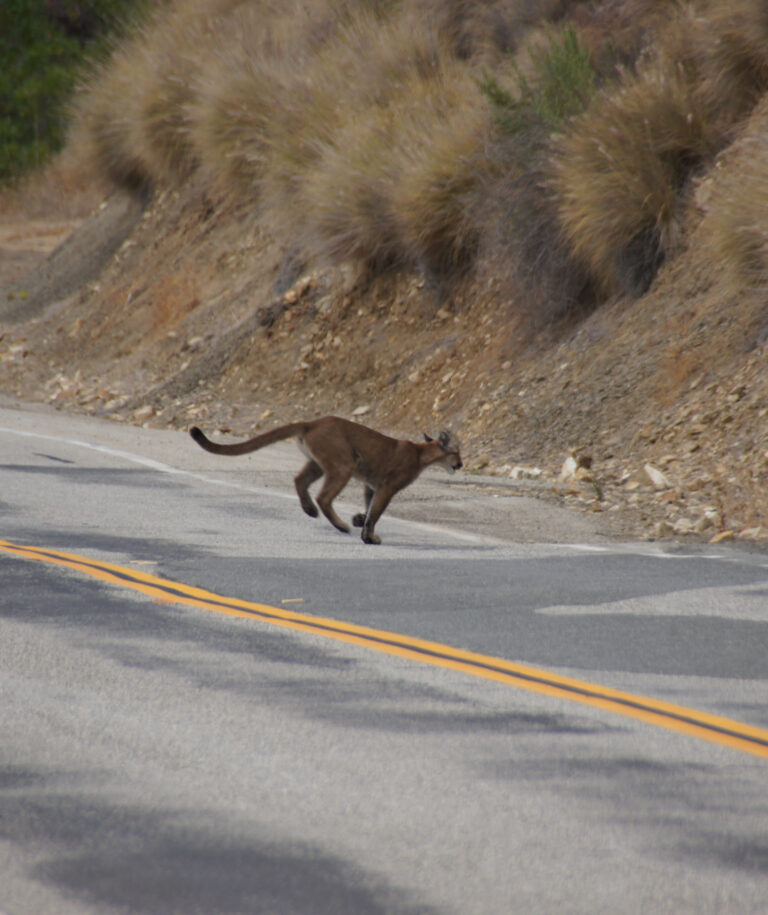Mountain Lions Pushed Out by Wildfires Take More Risks

As reported below, wildfire can increase human-cougar conflict.
This shows why wildfire reduction with such tools as domestic animal grazing, and logging, is good for wildlife, and people.
NOTE: this article was originally published to ScienceNews.org on October 28, 2022. It was written by Bethany Brookshire.
California’s Woolsey Fire in 2018 led to local mountain lions crossing roads more often
Mountain lions have no interest in people, or the built-up areas we enjoy. But after a 2018 wildfire in California, local lions took more risks, crossing roads more often and moving around more in the daytime, scientists report October 20 in Current Biology. It’s another way the effects of human development could be putting pressure on vulnerable wildlife — in this case, potentially pushing them toward our bumpers.
The Woolsey Fire began near Los Angeles on November 8, 2018, and burned more than 36,000 hectares in the Santa Monica Mountains. Nearly 300,000 people evacuated, and three people died. Animals fled the fire too, including the local mountain lions (Puma concolor). The fire was a tragedy, but also a scientific opportunity, says Rachel Blakey, a global change biologist at UCLA. Many of the lions wore tracking collars, allowing scientists to study how the fire changed their behavior.

A mountain lion wearing a tracking collar leads her cubs through the brush. Collars on cats like these allow scientists to track where the animals go when wildfires ravage their territories. – NATIONAL PARK SERVICE
Of the 11 collared cougars in the area at the time, nine made it to safety during the fire itself. “They have really large home ranges, so it’s nothing to them to be able to cover many kilometers in a day,” Blakey says.
No matter how much they moved, the mountain lions avoided people. One collared cat, P-64, initially fled the fire — until he got close to a developed area. Given the choice between fire and people, the lion retreated back into the burning area. “That’s where his movements stopped,” Blakey says. The park service later found P-64’s remains. He’d burned his paws, and it’s possible that he was unable to hunt and starved to death.
Using data from the nine lions that survived the fire and others collared after, the scientists showed that the cats generally avoided the severely burned areas of their territories. With vegetation gone, the cats had little cover for stalking and ambushing prey.
Instead, the cougars stuck to unburned areas, and continued to avoid people. But they took more risks around human infrastructure, increasing their road crossings from an average of about three times per month to five.

After the Woolsey Fire in 2018, mountain lions in the Santa Monica Mountains crossed roads more often, a risky move that could put the cats’ lives in danger. – NATIONAL PARK SERVICE
These weren’t all two-lane country highways. The first collared lion to successfully cross Interstate 405, which has 10 lanes in places, did it after the Woolsey Fire. And the big cats crossed U.S. Route 101 once every four months, whereas before the fire, they’d crossed only once every two years. Their territories also overlapped more often, increasing the potential for deadly encounters between the solitary cats. And the generally nocturnal animals increased activity during daytime hours from 10 percent to 16 percent of their active time — boosting a lion’s chances of potentially bump into a human.
Road crossing is what Blakey calls a “risk mismatch.” Lions in areas with lots of people appear to weigh the risk of encountering humans as more dangerous. But “running across a freeway is a lot more likely to be fatal,” she says. That risk, combined with the risk of running into other cats, can be deadly. One young, collared male ended up dead on a freeway in the months after the fire. He was fleeing a fight with an older, uncollared male.
Intense burns like the Woolsey Fire highlight the resilience of mountain lions, says Winston Vickers, a wildlife research veterinarian at the University of California, Davis who was not involved in the study. “They have amazing mobility, they mostly can get away from the immediate fire, they mostly survive,” he notes. The changes in risk-taking, he says, could reflect how confined the population is, hemmed into the mountains by human development.
Wildlife crossings, such as the new Wallis Annenberg Wildlife Crossing over the 101, will hopefully give the mountain lions a safer option for roaming, though the main goal is to promote gene flow between lion populations, Blakey says (SN: 5/31/16). In a landscape where fire, humans and highways combine, it’s good to have somewhere to run.
